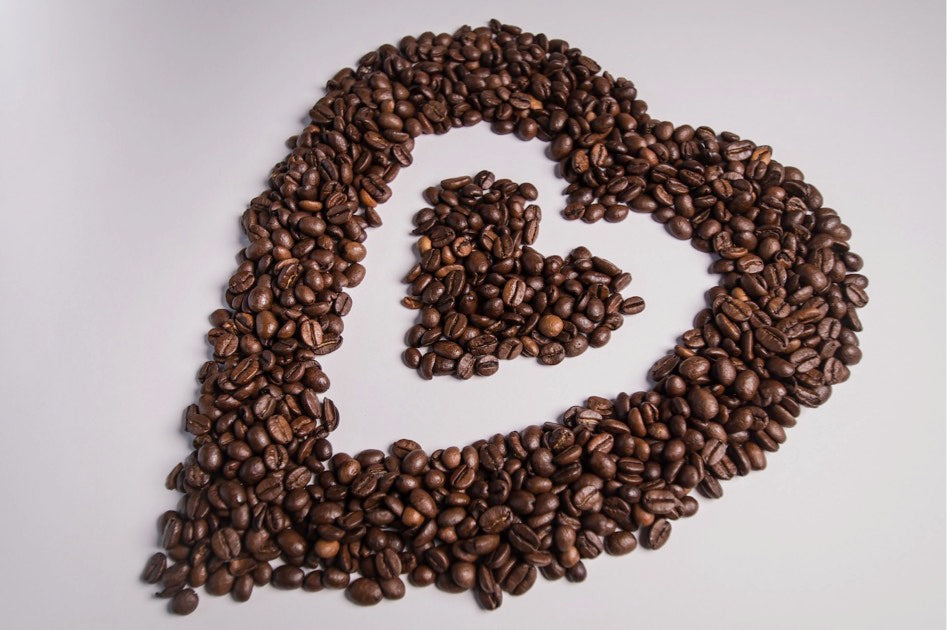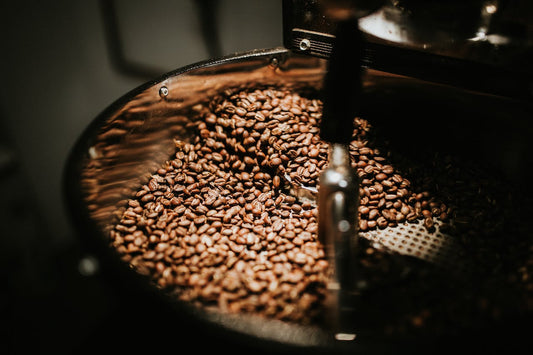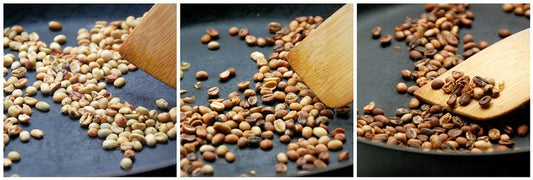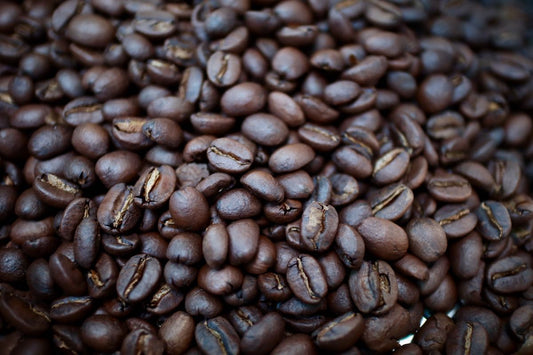
Coffee Roast Profiles
Coffee roast profiles are, ultimately, what create that perfect balance of acidity, sweetness, and bitterness.
But if you're here, you want to know more than they just make a great cup of coffee. You really want to understand exactly what coffee roasting profiles are.
And that's why we've put this guide together.
Whether you're home roasting your coffee beans today, a seasoned roaster, or simply an enthusiast that wants to learn everything you can about that cup you love so much, this article will walk you through everything you need to know about unlock coffee roasting profiles.
Let's kick things off with level setting and defining what are commonly called "roast profiles."
Coffee Roast Profiles
Coffee roasting profiles are the secret recipes that transform green, un-roasted coffee beans into the aromatic, flavorful gems we cherish.
A coffee roasting profile is essentially a journey, a carefully choreographed sequence of events that a coffee bean goes through during the roasting process.
Imagine a symphony where the conductor is the roaster, and the coffee bean is the instrument. The conductor skillfully guides the tempo and intensity, just like the roaster crafts the temperature and time throughout the roasting process.
The result?
A harmonious cup of coffee that tells a story with every sip.
More directly, you can think of a roast profile as the result of a roast curve that takes a particular bean to a desired roast level.
To better understand what this means, we'll describe both the roast curve and the roast levels in more detail.
First though, we have to understand what takes place during a roast. Or as we call them, the stages of coffee roasting.
Stages of Coffee Roasting
Much like a blockbuster movie with its distinct acts, the coffee roasting process unfolds in a series of stages, each contributing to the final masterpiece.
Man, what's with me and flowery language?
The stages of coffee roasting are simply things that happen in a repeatable order and result in a roasted bean that's ready to drink.
1. Charging
The first stage, known as charging, sets the scene for the journey ahead.
You put green coffee beans in the roaster and the process begins. It's like the opening scene of a movie, capturing your attention and hinting at the adventure to come.
If I'm being honest, this is less of a stage though, and more of a thing that you have to do. This is simply where you add the beans to the roaster.
We won't go into detail here, but "at what temp" you charge is super important.
And since this effectively is the foundation of the next few stages, it's important enough to call out as it's own stage.
2. Drying
As the beans heat up, the moisture within them evaporates in a process called drying.
This stage is crucial because it prepares the beans for the chemical reactions that lead to flavor development.
It's akin to the rising action in a story, building anticipation and setting the foundation for what's to follow.
The difference being the part that follows usually leads to a great cup of coffee.
But it's just the start.
Once the beans are dry, noticed by a pailing green color, they'll start to enter the next phase, browning.
3. Browning
Here, the beans undergo the Maillard reaction, a complex chemical process that brings forth a wealth of flavors and aromas.
The beans transition from green to a light brown color, and the air is filled with the tantalizing scents of caramelization and toasting.
This stage is like the climax of a story, where everything comes together before a burst of excitement.
Personally, this stage creates the most enjoyable pre-coffee smells during the roast. It's a deliciously sweet caramel smell.
And now I'm talking about pre-coffee smells... yikes.
Moving past the sweet smells and the browning, the beans move into what's commonly called the developing stage
4. Developing
Many say that this is the stage where the magic truly happens.
The roaster controls the temperature and time to shape the flavor profile of the coffee. Acidity, sweetness, and bitterness are balanced in a delicate dance, creating a coffee that's uniquely enjoyable.
And they'll say that this is the resolution of our story, where conflicts are resolved and characters find their purpose.
Unfortunately, this really isn't the whole story.
The development of the roast starts the moment the beans are charged.
Temperature and time through the various milestones of the roast (think turning point, yellowing, and the time between yellowing and first crack) all contribute to the development of the roast.
What does happens though is that the characteristics of the roast level get developed here.
In complicated jargon, that's to say that the roast level characteristics become more prominent than the origin profiles of the bean during the development stage.
Here's an example.
Let's say you bought Hostess marshmellows becuase you think they taste so good you'll eat them right out of the bag.
The flavor you like here would be the origin profile of your marshmellows. In this case the Hostess origin.
On Friday night, you went out to a bonfire to roast some marshmellows as a late summer treat.
The longer you hold your Hostess marshmellow over the heat, it begins to roast and to taste a little different. You can tell it's hostess, but it's also changed flavor.
This change in flavor is the development of the roast level characteristics.
At first the marshmellow warms, then it golden browns as it softens on the side. Just a moment later, it's dark black and tastes like charcoal.
By the end, you can harly tell it started as a Hostess marshmellow.
It's the exact same with coffee.
Once the roast enters the first crack, it's as much origin as is drinkable.
The further beyond this point, the more tastes of the roast level will dominate the flavor.
This isn't at all bad, in fact, many prefer these typical flavors.
It's just to say that what's commonly called the "developing" stage is really just the development of the roast level but much of the origin characteristics are influenced by the earlier stages.
But we're not done yet.
Let's stop talking marshmallows and get back to our coffee roasting profiles.
If we keep roasting, we'll soon have a oily fireball in our roaster.
So let's drop our beans and move onto the cooling phase.
5. Cooling
The final stage involves cooling the beans rapidly to halt the roasting process.
Just like the closing credits of a movie, it's a time to reflect on the journey and savor the accomplishments.
The difference being, it doesn't take as long and there's no hope of a 30 second teaser at the end.
Don't underestimate this part of the process though.
When done correctly, this stage preserves the flavors developed during roasting, and ensures that every cup of coffee is a testament to your skill as a roaster.
At this point, we've finished roasting the beans and completed the creation of a coffee roasting profile.
But during these stages, we went through a particular roast curve.
Let's learn more about roast curves next.
Understanding Roast Curves
At the heart of a coffee roasting profile lies the roast curve.
Think of it as the script that guides the entire roasting process.
A roast curve plots the temperature of the beans over time, revealing the key milestones that shape the final outcome.
It's the when that these milestones take place, from charge to drop, that really develop the roast.
Let's take a deeper look.
What Roast Curves Are
Roast curves showcase the journey of the coffee bean, from the initial charge to the final cooling.
They provide valuable insights into the rate at which the beans heat up and the pivotal moments where flavors are developed.
Think about it in terms of a line on the chart, like the one below.
As you add cool beans to the roaster, the roaster will cool down a bit before, at some point, begining to increase in heat again.
It will heat all the way through first crack, maybe second, and you'll drop the beans.
This like, will look like a sloppy check mark at the end.
That's what we refer to as the roast curve.
But to really understand this, you need to understand the various milestones throughout the curve.
Key Milestones
Throughout the roast curve, certain milestones mark significant shifts in the coffee's composition.
Turning Point:
This marks the point at which the bean temperature inside the roaster has stopped decreasing, and begins to increase.
Yellowing:
This marks the end of the drying phase and the beginning of the browning stage. The beans literally turn yellow.
First Crack:
This marks the beginning of the development stage and is a crucial indicator for roasters.
Second Crack:
This marks the beginning of the "dark" roast levels.
And while it's technically not a milestone of the roast curve, we can't talk about roast curves and not introduce the Rate of Rise.
Rate of Rise
This is one of the dorkier bits of roasting, but arguably it's one of the most important.
This is the rate at which the temperature of the beans rises over time, known as the Rate of Rise (RoR).
A key factor in determining the coffee's flavor profile, a steeper RoR might lead to brighter acidity, while a gentler RoR could contribute to a smoother, sweeter cup.
Roasters carefully adjust the RoR to achieve the desired characteristics.
Generally speaking, you'll want to have a "decreasing rate of rise" for the coffees we typically roast at home.
Now that we understand the stages of coffee roasting, roast curves and the keypoints along that curve, we can finally speak to roast levels.
Roast Levels
Coffee roasting profiles give birth to a spectrum of roast levels, from light to dark.
Each offes a unique experience to the discerning coffee drinker.
As we elluded earlier, roast levels are referring to the varying degrees of departure from the origin's characteristics of the bean.
Most typically associated to roast color, the level to which we roast is commonly categorized into 4 groups.
We dive into coffee roast levels in detail here, but for now, here's a brief summary for you.
Light Roast
These are the roasts that are in the roaster for the least amount of time.
In a light roast, the coffee's origin flavors shine through.
The beans are brought to just the right temperature to preserve their origin characteristics, resulting in a cup that's vibrant and acidic.
This roast level is like the delicate brushstrokes of an artist, capturing the essence of the coffee's birthplace. Blah....
Medium Roast
A medium roast strikes a balance between the coffee's original flavors and the roast level characteristics.
The beans are slightly darker, usually offer a fuller body and a touch of sweetness.
These are like a perfectly roasted marshmellow. Starten to darken on the outside, but still very clearly Hostess.
Medium-Dark Roast
As we venture into medium-dark roast territory, the flavors become richer and more intense.
There's a hint of bitterness, accompanied by notes of chocolate and toasted nuts.
Depending on the origin, these can be some the most common "daily drivers" you see in cafes, dinners, coffee shops, and the world around.
Think Pikes from Starbucks.
Dark Roast
Dark roast coffee is bold and powerful, with pronounced bitterness and a deep, smoky aroma.
The beans are taken to higher temperatures, leading to the development of roasted and caramelized notes.
These are most commonly your Italian and French roasts and most enjoyed people that enjoy being able to clean the grease off their engines with their morning cups of coffee.
An Opinion about color
While some coffee aficionados might strongly assert what is and isn't a light, medium, or dark roast coffee, the reality is the roaster that uses temperature as their guide will always "know" what their coffee is.
Being able to identify roasts by color is good, but it's not the whole story.
Let's talk about the story arc now a bit. How do you write a story that ends with a delicious cup of coffee?
My mastering the application of time and temperature.
Influencing the perfect coffee roast profiles
Crafting the perfect coffee roast is a blend of science, art, and intuition. Roasters have two primary levers to influence flavor: temperature and time.
Both influence one another. More heat, less time. More time, less heat. All of which result in different profiles.
Let's take a brief look at each.
Temperature
Temperature plays a pivotal role in the coffee roasting process.
From the initial charge to the final cooling, it's the conductor's baton that guides the symphony of flavors.
Higher temperatures might accelerate the roast, leading to bolder flavors, while lower temperatures can preserve delicate nuances.
The right temperature at the right time shapes the final flavor profile.
Time
Time is the storyteller's pen, carefully adding layers and depth to the narrative.
Extending the roasting time can bring out nuanced flavors, while shorter times might result in brighter acidity.
Just as a novelist knows when to build suspense and when to reveal a plot twist, a roaster knows how to manipulate time for the perfect cup.
Ultimately though it's the combination of both time and temperature that dictates the end result.
But how do you know it if was a good coffee roasting profile or note?
Judging the Roast Profile
Appreciating a coffee roasting profile is like enjoying a blockbuster movie—it's a personal experience that's enhanced when shared.
Here are two ways you and your friends can judge a coffee profile:
Your Palate
Your taste buds are the ultimate judges.
Does it taste good to you?
If it does, pay attention to the flavors that dance on your tongue.
Do you detect fruity undertones, a hint of chocolate, or a satisfying bitterness?
Each coffee has a story to tell, and your palate is the reader.
The more stories you read and the more you learn the flavors you enjoy most is the surest path to a consistently good roast.
Experiences are Best Shared.
Brew a pot of coffee from the same roast profile and share it with friends.
Compare notes and see what flavors each person perceives.
It's a journey of discovery, where your individual perceptions contribute to a collective understanding.
Me and my friends do this regularly and every time I learn how to get better and what they enjoy. This makes it fun to roast a batch just for them.
Wrapping Coffee Roast Profiles Up:
As we end this exploration of coffee roasting profiles, remember that every cup of coffee is a unique story waiting to be savored.
Creating a rockstar coffee roasting profile is a symphony of temperature, time, and technique, all orchestrated to create a flavorful masterpiece.
Whether you're drawn to the bright notes of a light roast or the bold richness of a dark roast, every roasted coffee offers a journey of discovery and delight.
So, the next time you enjoy your morning brew, take a moment to appreciate the journey those beans have undertaken.



